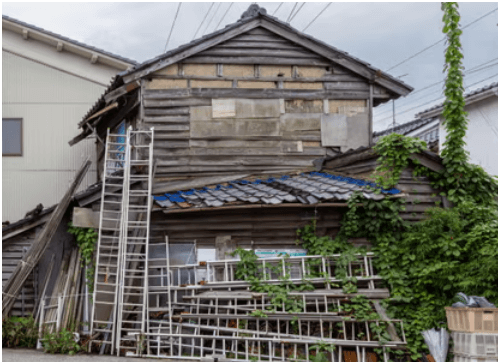Japan’s Housing Puzzle: Report Explores the Mystery Behind 9 Million Vacant Homes
The staggering number of vacant homes in Japan, estimated at around 9 million (90 lakh), has become a pressing issue with profound social, economic, and cultural implications. A recent report sheds light on the underlying factors contributing to this phenomenon, offering insights into the complex dynamics of Japan’s housing market and demographic trends.
Aging Population and Rural Depopulation:
One of the primary drivers behind the high number of vacant homes in Japan is the country’s aging population and rural depopulation. As younger generations migrate to urban centers in search of education and employment opportunities, rural communities are left with shrinking populations and surplus housing stock. This demographic shift has led to a surplus of vacant homes, particularly in rural areas where the population decline is most pronounced.
Inheritance and Succession:
Another factor contributing to the prevalence of vacant homes in Japan is the traditional practice of inheritance and succession. In many cases, elderly homeowners pass away without designated heirs or successors to inherit their properties. As a result, these homes remain unoccupied and unused, contributing to the overall vacancy rate. Complicated inheritance laws and cultural norms surrounding property ownership further complicate the process of transferring ownership and utilizing vacant homes.
Economic and Structural Issues:
Economic factors also play a role in the prevalence of vacant homes in Japan. Economic stagnation, declining property values, and the high cost of maintenance and renovation make it financially unfeasible for property owners to invest in vacant homes or put them on the market. Additionally, many vacant homes suffer from structural issues or are located in areas prone to natural disasters, further diminishing their appeal to potential buyers or renters.
Cultural Perceptions and Stigma:
Cultural attitudes towards homeownership and property maintenance also contribute to the phenomenon of vacant homes in Japan. In some cases, vacant homes are viewed as undesirable or stigmatized, leading property owners to delay or avoid addressing the issue. Cultural norms surrounding the sanctity of property ownership and the reluctance to sell or rent out inherited homes exacerbate the problem, perpetuating the cycle of vacancy and neglect.
Policy Responses and Urban Revitalization:
Addressing the issue of vacant homes in Japan requires a multifaceted approach that combines policy interventions, community engagement, and urban revitalization efforts. The Japanese government has implemented various measures aimed at incentivizing property owners to renovate or repurpose vacant homes, including tax breaks, subsidies, and support for community-based initiatives. Additionally, efforts to revitalize rural areas and promote sustainable development are key to addressing the root causes of vacant homes and revitalizing struggling communities. Innovative Solutions and Adaptive Reuse:
In response to the challenge of vacant homes, Japan has begun exploring innovative solutions and adaptive reuse strategies to repurpose unused properties and revitalize communities. One approach involves transforming vacant homes into shared spaces, community centers, or cultural hubs that serve the needs of local residents. By repurposing vacant homes in this way, communities can reclaim underutilized spaces and foster a sense of belonging and cohesion.
Additionally, some municipalities in Japan have launched initiatives to incentivize creative uses for vacant homes, such as converting them into guesthouses, art studios, or small businesses. These initiatives not only breathe new life into vacant properties but also stimulate economic activity and promote tourism in rural areas.
Technology and Smart Solutions:
Technology also plays a role in addressing the issue of vacant homes in Japan. Some municipalities have adopted smart technology solutions, such as IoT sensors and monitoring systems, to detect and address issues related to vacant properties, such as maintenance, security, and energy efficiency. These technological innovations help property owners better manage their vacant homes and mitigate the negative impacts of vacancy on surrounding communities.
Community Engagement and Grassroots Initiatives:
Community engagement and grassroots initiatives are essential components of efforts to address vacant homes in Japan. Local residents, community organizations, and grassroots movements play a crucial role in identifying vacant properties, advocating for solutions, and implementing revitalization projects. By fostering collaboration and collective action at the grassroots level, communities can harness local knowledge and resources to address the root causes of vacancy and create sustainable solutions tailored to their unique needs.
Long-Term Planning and Sustainable Development:
Ultimately, addressing the issue of vacant homes in Japan requires long-term planning and a commitment to sustainable development. Policymakers, urban planners, and community stakeholders must work together to develop comprehensive strategies that promote equitable access to housing, support vibrant communities, and preserve cultural heritage. By prioritizing sustainable development goals and integrating vacant home revitalization efforts into broader urban planning initiatives, Japan can create resilient, inclusive communities that thrive for generations to come.
The prevalence of vacant homes in Japan is a complex and multifaceted issue driven by demographic, economic, and cultural factors. As Japan grapples with an aging population, rural depopulation, and changing societal norms, addressing the issue of vacant homes is essential to promoting sustainable development, revitalizing communities, and ensuring the efficient use of resources. By implementing targeted policies, fostering community engagement, and promoting innovative solutions, Japan can mitigate the impact of vacant homes and create vibrant, livable communities for current and future generations.
Stay informed with the latest updates – click here .












Add Comment